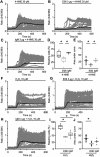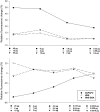Antinociception by the anti-oxidized phospholipid antibody E06
- PMID: 29679953
- PMCID: PMC6016623
- DOI: 10.1111/bph.14340
Antinociception by the anti-oxidized phospholipid antibody E06
Abstract
Background and Purpose: ROS and their downstream molecules such as oxidized phospholipids (OxPL) and 4‐hydroxynonenal activate TRPA1 and TRPV1 (vanilloid 1) cation channels in vivo and in vitro shaping thermal and mechanical hypersensitivity in inflammatory pain. E06/T15 is a monoclonal autoantibody against oxidized phosphatidylcholine (OxPC) used in diagnostics in arteriosclerosis. Recently, we provided evidence that E06 also ameliorates inflammatory pain. Here, we studied E06 for local treatment against hypersensitivity evoked by endogenous and exogenous agonists of TRPA1 or TRPV1 channels.
Experimental Approach: We utilized a combination of reflexive and complex behavioural pain measurements, live‐cell calcium imaging and OxPC‐binding assays. The lipid peroxidation metabolite 4‐hydroxynonenal, hydrogen peroxide as a source of ROS, allyl isothiocyanate and capsaicin were used to activate their respective receptors.
Key Results: All irritants induced thermal and mechanical hypersensitivity, spontaneous nocifensive and affective‐motivational behaviour, as well as calcium influx in HEKTRPA1‐ or HEKTRPV1‐cells and dorsal root ganglion neurons. E06 prevented prolonged mechanical hypersensitivity induced by all irritants except for H2O2. E06 did not alter immediate irritant‐induced nocifensive or affective motivational behaviour. In vitro, E06 blocked only 4‐hydroxynonenal‐induced calcium influx although this compound did not bind to E06. After 1–3 h, all tested irritants elicited formation of OxPC in paw tissue.
Conclusions and Implications: E06 ameliorates not only inflammatory pain but also prolonged hypersensitivity due to formation of OxPC. This supports the view that neutralizing certain OxPL as endogenous activators of TRPA1 or TRPV1 channels may be valuable for pain therapy.
Figures









Similar articles
-
Inflammatory pain control by blocking oxidized phospholipid-mediated TRP channel activation.Sci Rep. 2017 Jul 14;7(1):5447. doi: 10.1038/s41598-017-05348-3. Sci Rep. 2017. PMID: 28710476 Free PMC article.
-
Evodiamine suppresses capsaicin-induced thermal hyperalgesia through activation and subsequent desensitization of the transient receptor potential V1 channels.J Nat Med. 2016 Jan;70(1):1-7. doi: 10.1007/s11418-015-0929-1. Epub 2015 Jul 19. J Nat Med. 2016. PMID: 26188960 Free PMC article.
-
17(R)-resolvin D1 specifically inhibits transient receptor potential ion channel vanilloid 3 leading to peripheral antinociception.Br J Pharmacol. 2012 Feb;165(3):683-92. doi: 10.1111/j.1476-5381.2011.01568.x. Br J Pharmacol. 2012. PMID: 21718307 Free PMC article.
-
The potential of transient receptor potential vanilloid type 1 channel modulators for the treatment of pain.J Med Chem. 2007 May 31;50(11):2589-96. doi: 10.1021/jm060637e. Epub 2007 May 10. J Med Chem. 2007. PMID: 17489570 Review. No abstract available.
-
TRPV1 antagonists as a potential treatment for hyperalgesia.Recent Pat CNS Drug Discov. 2006 Jan;1(1):65-76. doi: 10.2174/157488906775245309. Recent Pat CNS Drug Discov. 2006. PMID: 18221192 Review.
Cited by
-
Autoantibodies to Oxidatively Modified Peptide: Potential Clinical Application in Coronary Artery Disease.Diagnostics (Basel). 2022 Sep 20;12(10):2269. doi: 10.3390/diagnostics12102269. Diagnostics (Basel). 2022. PMID: 36291959 Free PMC article.
-
Pain Control by Targeting Oxidized Phospholipids: Functions, Mechanisms, Perspectives.Front Endocrinol (Lausanne). 2021 Jan 25;11:613868. doi: 10.3389/fendo.2020.613868. eCollection 2020. Front Endocrinol (Lausanne). 2021. PMID: 33569042 Free PMC article. Review.
-
Oxidized phospholipids in cardiovascular disease.Nat Rev Cardiol. 2024 Mar;21(3):170-191. doi: 10.1038/s41569-023-00937-4. Epub 2023 Oct 17. Nat Rev Cardiol. 2024. PMID: 37848630 Review.
-
Neutralizing Oxidized Phosphatidylcholine Reduces Airway Inflammation and Hyperreactivity in a Murine Model of Allergic Asthma.Biology (Basel). 2024 Aug 17;13(8):627. doi: 10.3390/biology13080627. Biology (Basel). 2024. PMID: 39194564 Free PMC article.
-
D-4F, an ApoA-I mimetic peptide ameliorating TRPA1-mediated nocifensive behaviour in a model of neurogenic inflammation.Mol Pain. 2020 Jan-Dec;16:1744806920903848. doi: 10.1177/1744806920903848. Mol Pain. 2020. PMID: 31996074 Free PMC article.
References
-
- Bautista DM, Jordt SE, Nikai T, Tsuruda PR, Read AJ, Poblete J et al (2006). TRPA1 mediates the inflammatory actions of environmental irritants and proalgesic agents. Cell 124: 1269–1282. - PubMed
Publication types
MeSH terms
Substances
LinkOut - more resources
Full Text Sources
Other Literature Sources
Medical

